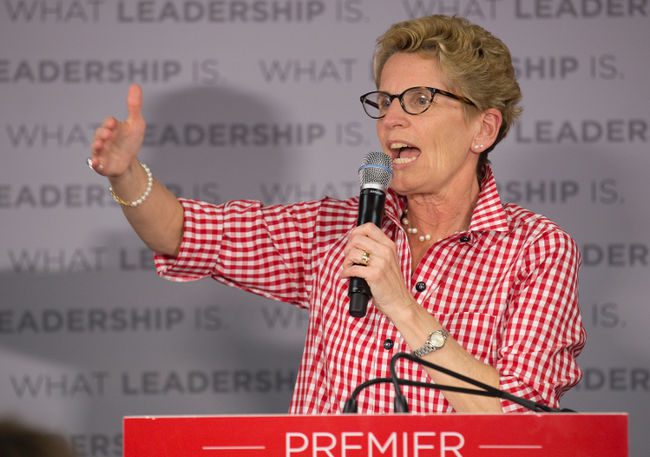How did Wynne make a miraculous poll vaulting jump in support in the latest poll released by Innovative Research Group (IRG)? Of course this should be put in context, which so many journalists fail to do in reporting polls. IRG is an unreliable pollster if its spectacular failure in predicting the B.C. Liberals having the edge (Christy Clark just resigned Friday) in the province's recent election is any indicator. According to IRG, Wynne's OLP have sprung from a record low of 12 per cent support in March up to 35 per cent in July, a jump of 22 per cent. I'll wait for more polls before I actually believe Wynne has sprung from the dead, doubling her popularity in a few months' time, but if there is even a grain of truth to this most recent poll, Wynne's Liberals seem to be recuperating from flatlining.
Apparently Wynne's bag of goodies (read voter bribes) seem to be working, but what is more likely to have already swayed public support is the bottom line of today. In June, the 17 per cent hydro rate reduction took effect. Perhaps this appeased some angry Ontarians. The Wynne government's propaganda campaign trumpeting the reduction could only have helped.
The Ontario Liberal Party was patted on the back for bringing in campaign finance reform late last year, passing the Election Finances Act. The Act was supposed to end cash-for-access events, which Wynne partook in regularly in her first few years in office, as well as end corporate and union contributions to parties and impose restrictions on third-party advertisers. Although the move looked like the Liberals were giving up a large advantage in their ability to out fundraise their opponents, the new legislation also put taxpayers on the hook for giving each party $2.71 per vote received in the last election. This translated to the Liberals receiving $5.06 million, the Conservatives, NDP and Green getting $4.09 million, $3.1 million and $630,000 respectively. This means the Liberals still received just under $1 million more in taxpayer funding to their party from the government (themselves) than the next closest rival, and will receive the same advantage next year.
On top of this, wily Premier Kathleen Wynne loosened the government advertising rules the previous year. This is why Wynne's "Fair Hydro Plan" ads have been inundating Ontarians the last several months, despite the chagrin it has caused the hands-tied auditor general Bonnie Lysyk, who, according to the National Post, said the changes "reduced her office to a rubber stamp."
The hyper-partisan ads, which I've already mocked, say "we've heard you" and falsely advertise that Ontarian ratepayers are getting an average of an additional 25 per cent off their hydro, instead of the actual 17 per cent reduction being given (Wynne's government includes, fraudulently, the 8 per cent provincial HST taken off bills at the beginning of the year). The ads make no mention of the $21 billion burned up in additional interest payments, or that taxpayers will have to pay more in the next couple years to help offset the cost to the province. Energy Minister Glenn Thibeault said Wynne's government "spent under $1 million on both the radio ads and the social media ads" back in March. Since then, the ads have been ubiquitous, on television, radio, print and social media. I suspect millions have been spent since Thibeault's low estimate, and I intend to find out just how much of taxpayers money they've burned to brainwash them into thinking they're doing a good job with taxpayers' money.
Either way, the OLP is getting plenty of free government advertising to repair its image because of how it loosened the rules. I'll be looking into just how they buggered with government advertising legislation in 2015, how much they're spending on this uninformative PR ad blitz and whether or not this latest (likely push) poll reveals it's actually working. Stay tuned.
Written by Graeme C. Gordon






